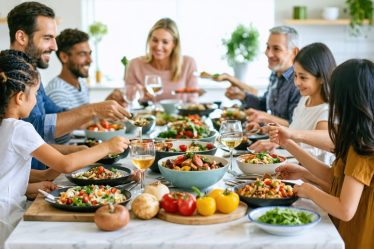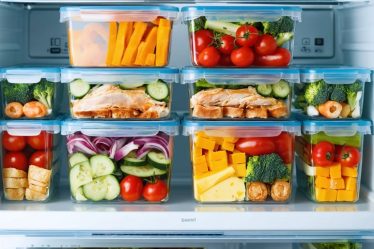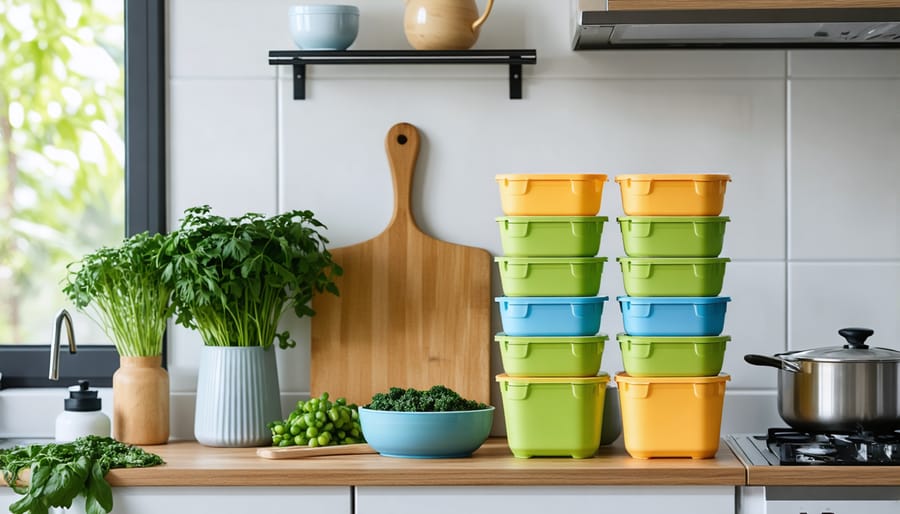
Transform your Sunday afternoon into a gateway to stress-free weekday meals through the art of batch cooking. Picture opening your refrigerator to find neatly organized containers filled with colorful, ready-to-eat meals – each one a testament to your commitment to both wellness and efficiency. Batch cooking isn’t just about preparing food in advance; it’s a mindful practice that creates space for both nourishment and peace in your busy life.
Gone are the rushed weeknight dinner scrambles and expensive takeout orders. Instead, imagine having the freedom to spend your evenings doing what truly matters, knowing that a healthy, home-cooked meal is just minutes away from your table. This intentional approach to meal preparation does more than save time – it reduces food waste, cuts grocery costs, and brings a sense of calm to your daily routine.
Whether you’re a busy professional, a dedicated parent, or simply someone seeking more balance in their life, batch cooking offers a practical solution to the eternal question: “What’s for dinner?” Let’s explore how this transformative practice can help you reclaim your time while nurturing yourself and your loved ones with wholesome, thoughtfully prepared meals.
The Mindful Approach to Batch Cooking
Creating Your Kitchen Sanctuary
Before diving into batch cooking, let’s create a kitchen space that welcomes and inspires you. I’ve found that developing mindful cooking habits starts with your environment. Begin by clearing your countertops of unnecessary items, keeping only the essentials you’ll need for your prep session. I love to open windows for fresh air and natural light – it’s amazing how this simple act can lift your mood.
Create designated zones for different tasks: a prep station with your cutting board and knives, a cooking area near the stove with frequently used spices and oils, and a packaging station for storing your finished meals. Consider playing soft background music or your favorite podcast to make the experience more enjoyable.
Remember to gather all your ingredients and tools before starting. This prevents the frustration of hunting for items mid-cook. I like to keep a small vase of fresh herbs or flowers on my counter – it’s a simple touch that makes the space feel more intentional and peaceful. When your kitchen feels like a sanctuary, batch cooking becomes less of a chore and more of a self-care ritual.
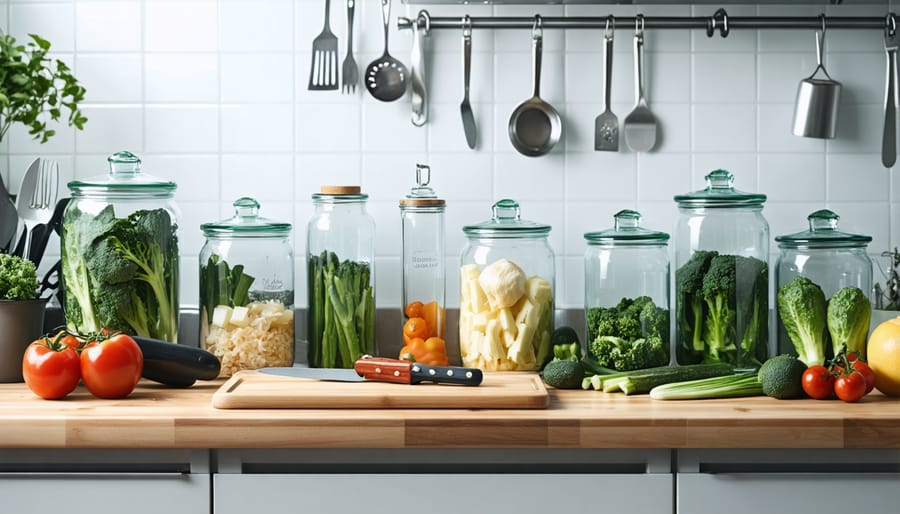
Intentional Ingredient Selection
When I first started batch cooking, I quickly learned that the success of my meals hinged on choosing the right ingredients. Start by selecting versatile staples that can work in multiple dishes – think sweet potatoes, quinoa, and lean proteins like chicken breast. These foundation ingredients should be both nutritious and adaptable to different flavor profiles.
Focus on incorporating a rainbow of vegetables, which not only adds visual appeal but ensures you’re getting diverse nutrients throughout the week. I always include at least one leafy green, several colorful vegetables, and some hearty root vegetables in my shopping list.
Consider the shelf life of your ingredients when planning. Hardier vegetables like carrots and cabbage can last longer, while more delicate items like fresh herbs should be used in early-week meals. When selecting proteins, choose options that reheat well – salmon and tofu are excellent choices that maintain their texture.
Remember to balance your meals with adequate portions of proteins, complex carbohydrates, and healthy fats. This ensures your prepared meals will keep you satisfied and energized throughout the week.
Essential Prep Strategies That Work
Smart Planning Systems
The secret to successful batch cooking lies in developing smart meal prep strategies that work for your lifestyle. I’ve found that taking 15 minutes on a quiet evening to plan the week ahead makes all the difference. Start by checking your calendar for the upcoming week – knowing which nights you’ll be working late or have events helps determine how much cooking you’ll actually need to do.
Create a simple planning system that works for you. I use a digital notepad on my phone to list meal ideas, but many of my friends swear by pretty paper planners or magnetic whiteboards on their fridges. Whatever method you choose, include spaces for your menu, shopping list, and prep schedule.
When planning your menu, think in terms of compatible ingredients. For example, if you’re roasting vegetables for Monday’s dinner, plan to roast extra for Tuesday’s grain bowls. This approach not only saves time but also reduces food waste and simplifies your shopping list.
Speaking of shopping lists, organize yours by store layout to avoid backtracking. I group items by department: produce, proteins, pantry items, and so on. Keep a running list throughout the week, adding items as you run low. This prevents those frustrating moments when you’re ready to cook and realize you’re missing a key ingredient.
Time-Saving Kitchen Workflows
The secret to successful batch cooking lies in mastering your workflow, and it all starts with an efficient kitchen setup. I learned this the hard way after countless Sundays of chaos before developing a system that works like a well-oiled machine.
Start by grouping similar tasks together. For instance, tackle all your chopping at once – this not only saves time but also means cleaning your cutting board just once. While vegetables are roasting in the oven, use that time to prepare marinades or cook grains on the stovetop. I love to brown meat while my rice cooker works its magic, maximizing every minute in the kitchen.
Layer your cooking tasks based on cooking times. Begin with items that take longest to cook, like roasted vegetables or slow-cooked proteins, then work your way down to quick-cooking items. Keep a kitchen timer handy and use different sounds for different dishes – this small hack has saved many of my meals from overcooking!
Create stations in your kitchen: one for prep work, another for cooking, and a third for cooling and packaging. This prevents cross-contamination and keeps your workflow smooth. Remember to clean as you go – those few minutes between steps are perfect for washing a cutting board or wiping down counters, making the final cleanup much more manageable.

Storage Solutions That Preserve Freshness
Let me share a game-changing discovery from my early meal prep days: proper storage is just as crucial as the cooking itself! I learned this the hard way when my carefully prepared meals lost their freshness by mid-week.
For optimal freshness, invest in high-quality glass containers with airtight lids. These aren’t just environmentally friendly; they’re also perfect for reheating and won’t retain food odors like plastic containers often do. I particularly love containers with compartments, which keep different components of your meals separate and maintain their individual textures.
When storing your prepped meals, remember these golden rules: cool everything completely before storing (to prevent condensation), label containers with contents and dates, and arrange items in your fridge with “first to eat” items at the front. For soups and sauces, leave a little headspace in containers as liquids expand when frozen.
Different foods have different storage sweet spots. Cooked grains and proteins typically stay fresh for 3-4 days in the fridge, while roasted vegetables are best consumed within 2-3 days. If you’re prepping for longer, consider freezing portions in individual servings – most cooked meals freeze beautifully for up to three months.
Pro tip: Keep fresh herbs and greens crisp by storing them in containers lined with slightly damp paper towels. This little trick has saved countless salads in my meal prep journey!
Mindful Meal Combinations
Versatile Base Recipes
The secret to successful batch cooking lies in mastering a few versatile base recipes that can transform into countless delicious meals. As a busy mom who’s cracked the code of family-friendly meal planning, I’ve found that starting with these foundational recipes saves both time and mental energy.
Let’s begin with a classic marinara sauce. One large batch can become the base for pasta dishes, homemade pizza, Italian-style shakshuka, or even a warming soup. I love making a double batch on Sunday evenings, using half for the week ahead and freezing the rest for future meals.
Next up is seasoned ground meat (beef, turkey, or plant-based alternatives). Cook it with basic aromatics like onions and garlic, then portion it out. This versatile base can transform into tacos, shepherd’s pie, stuffed peppers, or quick rice bowls throughout the week.
Roasted vegetables are another game-changer. A sheet pan of mixed seasonal vegetables can complement any protein, bulk up a grain bowl, blend into a smooth soup, or top a hearty salad. Pro tip: roast them slightly al dente if you plan to reheat them later.
Finally, don’t underestimate the power of a good grain prep. Cook a large batch of quinoa, rice, or farro – these can form the foundation of Buddha bowls, stir-fries, or warm salads. I often cook mine in broth instead of water for extra flavor, making them delicious enough to eat on their own.
Remember, these bases are just the beginning. The joy of batch cooking comes from mixing and matching these elements to create meals that feel fresh and exciting every time.
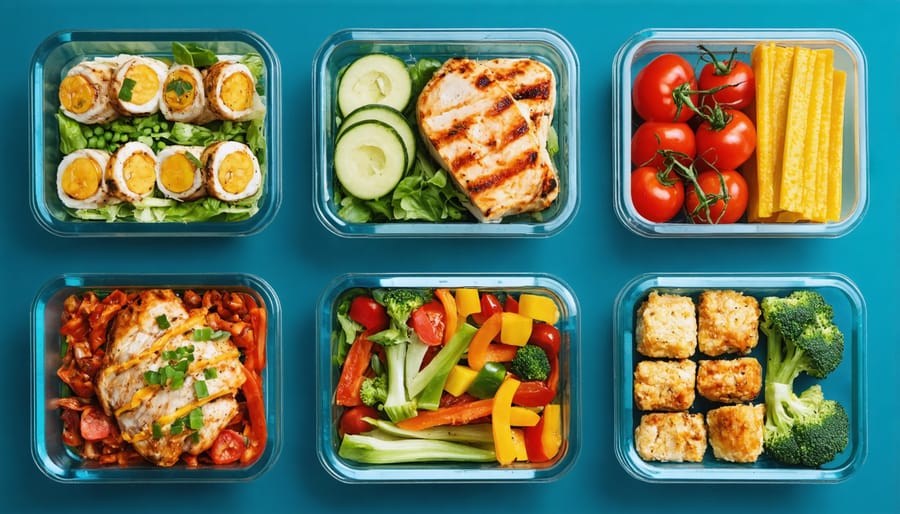
Creative Repurposing Techniques
Transform your batch-cooked basics into exciting new meals with these creative repurposing techniques! I learned this game-changing approach when I was struggling with meal prep monotony, and it’s completely revolutionized how I cook.
Start with your protein powerhouses. That big batch of shredded chicken can become multiple different meals: toss it into a quick stir-fry with fresh vegetables, fold it into creamy chicken salad for sandwiches, or transform it into a cozy chicken noodle soup. Even better, mix it with different sauces – think buffalo, BBQ, or teriyaki – for completely new flavor profiles.
Rice and grains are incredibly versatile base ingredients. Yesterday’s plain brown rice can become today’s vegetable fried rice, stuffed peppers, or rice pudding for dessert. I love turning leftover quinoa into breakfast bowls with fresh fruit and honey, or crafting savory quinoa patties for dinner.
Roasted vegetables are another meal prep staple that can wear many hats. Blend them into a creamy soup, puree them into a pasta sauce, or chop them finely to create a flavorful filling for quesadillas. My personal favorite is transforming roasted sweet potatoes into either a breakfast hash or a Thai-inspired curry.
Don’t forget about your sauces and dressings! A basic vinaigrette can become a marinade, while leftover pesto works beautifully as a sandwich spread or pizza base. The key is thinking of your batch-cooked items as ingredients rather than finished dishes – this mindset opens up a world of creative possibilities while saving you precious time in the kitchen.
Balancing Variety and Simplicity
When I first started batch cooking, I fell into the trap of making the same three meals on repeat. While it was efficient, dinner time became a bit… well, boring. The key to successful meal prep is finding that sweet spot between variety and simplicity.
Start by creating a rotating menu of 8-10 core recipes that your family enjoys. Think of these as your foundation meals – they should be reliable favorites that you can cook with your eyes closed. Then, introduce one new recipe every couple of weeks to keep things interesting without overwhelming yourself.
A smart approach is to use “mix-and-match” components. For example, prepare a batch of grilled chicken breasts that can star in different meals throughout the week: sliced over salads, diced in pasta, or shredded for tacos. The same goes for roasted vegetables – they can be side dishes, salad toppers, or the base for grain bowls.
Consider the “rule of three” when planning: choose three different proteins, three varieties of vegetables, and three bases (like rice, quinoa, or pasta). This simple framework gives you enough variety to create multiple meal combinations while keeping your prep sessions manageable.
Remember, it’s perfectly fine to keep some meals super simple while adding creative touches to others. The goal is sustainability, not perfection.
As we wrap up our journey into batch cooking meal prep, remember that this isn’t just about filling containers with food – it’s about creating a mindful, sustainable approach to nourishing yourself and your loved ones. By embracing batch cooking, you’re making a conscious choice to prioritize your wellbeing, save precious time, and reduce the daily stress of meal planning.
Starting small is key – perhaps begin with just two or three meals per week, and gradually build your confidence and repertoire. Listen to your body and adjust your meal prep according to your family’s preferences and schedule. The beauty of batch cooking lies in its flexibility; there’s no one-size-fits-all approach.
I’ve personally witnessed how batch cooking has transformed not just my kitchen organization, but my entire relationship with food. It’s allowed me to spend more quality time with my family during weekdays and approach cooking with intention rather than rushed obligation.
Remember, every container of carefully prepared food represents an investment in your future self. Whether you’re a busy professional, a parent juggling multiple responsibilities, or someone simply looking to bring more mindfulness to their meals, batch cooking can be your pathway to a more organized, peaceful, and nourishing lifestyle.
So, grab those meal prep containers, put on your favorite playlist, and start your batch cooking journey today. Your future self will thank you for taking this step toward a more mindful approach to meal preparation.


